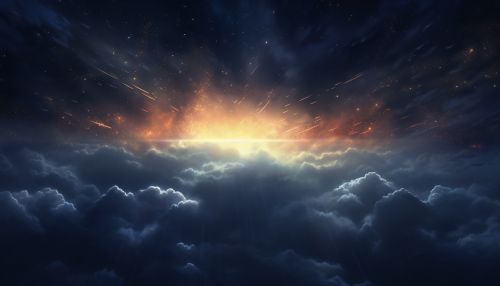Molecular Clouds
Introduction
Molecular clouds, also known as stellar nurseries, are the birthplaces of stars. These dense regions of the interstellar medium are primarily composed of molecular hydrogen (H2), with smaller amounts of other molecules such as carbon monoxide (CO), water (H2O), and ammonia (NH3). Molecular clouds are typically cold, with temperatures often below -200 degrees Celsius, and are characterized by their high densities and large masses. They are the primary sites of star formation in galaxies.


Structure and Composition
Molecular clouds are complex structures with a wide range of physical conditions. They can be divided into three main components: the dense core, the envelope, and the outer region. The dense core is the central part of the cloud where most of the mass is concentrated and where star formation occurs. The envelope surrounds the dense core and is composed of less dense gas and dust. The outer region is the least dense part of the cloud and is often influenced by the surrounding interstellar medium.
The primary component of molecular clouds is molecular hydrogen (H2), which makes up about 70-80% of the cloud's mass. The remaining mass is composed of helium and heavier elements, including carbon, nitrogen, oxygen, and silicon. These heavier elements are often found in the form of dust grains or as part of complex molecules such as carbon monoxide (CO), water (H2O), and ammonia (NH3). These molecules play a crucial role in the cloud's chemistry and physics, influencing processes such as cooling, heating, and the formation of new stars.
Formation and Evolution
Molecular clouds form from the interstellar medium, the space between the stars, which is filled with gas and dust. The formation process begins when a region of the interstellar medium becomes dense enough to collapse under its own gravity. This collapse can be triggered by a variety of mechanisms, including the shock waves from supernovae, the gravitational pull of nearby galaxies, or the turbulent motion of the interstellar medium itself.
Once a molecular cloud has formed, it begins to evolve. The cloud's dense core contracts under its own gravity, leading to the formation of protostars. These protostars continue to grow by accreting material from the surrounding cloud until they become dense and hot enough to ignite nuclear fusion, at which point they become stars. The remaining gas and dust in the cloud can form a protoplanetary disk around the new star, which may eventually lead to the formation of planets.
Over time, the molecular cloud is dispersed by the radiation and stellar winds from the newly formed stars. This process, known as photoevaporation, can lead to the destruction of the cloud and the end of star formation. However, some of the gas and dust may survive and be recycled into new molecular clouds, continuing the cycle of star formation.
Observation and Study
Molecular clouds are difficult to observe directly because their cold temperatures and high densities make them opaque to visible light. However, they can be detected indirectly through their effects on the light from background stars or by observing the emission from molecules within the cloud.
One of the most common methods for studying molecular clouds is through the observation of carbon monoxide (CO) emission. CO is a trace component of molecular clouds, but its strong emission lines make it an excellent tracer of the cloud's structure and dynamics. Other molecules, such as water (H2O) and ammonia (NH3), can also be used to probe different aspects of the cloud's physical conditions.
In addition to molecular emission, astronomers also study molecular clouds using dust emission. Dust grains within the cloud absorb light from nearby stars and re-emit it at longer wavelengths, producing a characteristic infrared glow. This emission can be used to measure the cloud's temperature and density, providing valuable information about the cloud's physical conditions and its potential for star formation.
Significance in Astronomy
Molecular clouds play a crucial role in the evolution of galaxies and the universe as a whole. They are the primary sites of star formation, and their properties determine the rate and efficiency of this process. By studying molecular clouds, astronomers can gain insights into the processes that lead to the formation of stars and planets, as well as the evolution of galaxies over cosmic time.
Furthermore, the complex chemistry that occurs within molecular clouds can lead to the formation of a wide variety of molecules, including many that are of interest to astrobiology. These include simple organic molecules, such as methanol (CH3OH) and formaldehyde (H2CO), as well as more complex molecules that are considered to be the building blocks of life. The study of these molecules can provide clues about the origins of life on Earth and the potential for life elsewhere in the universe.
